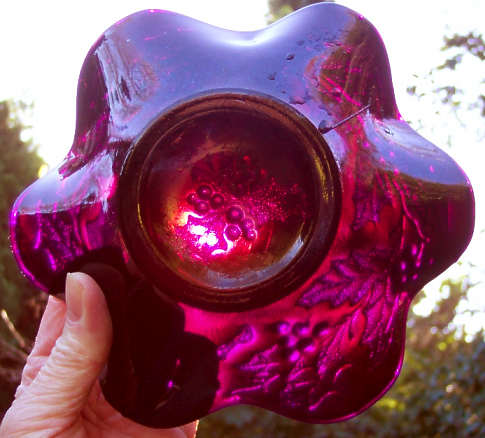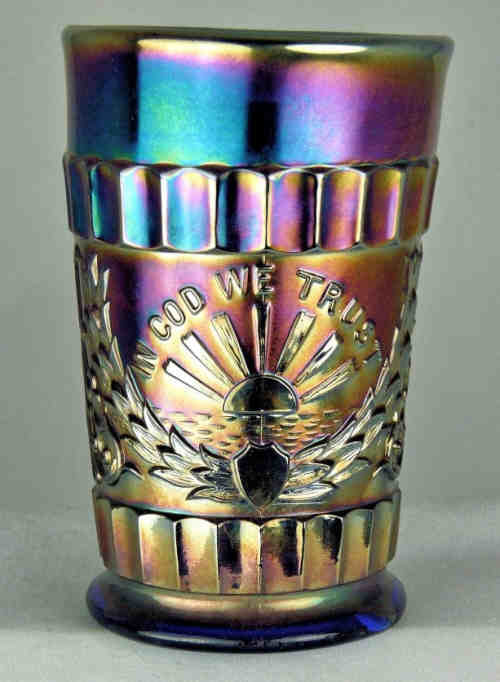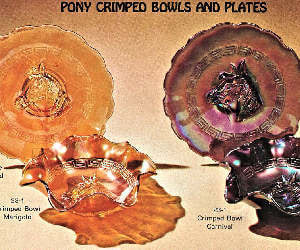Dugan-Diamond (Indiana, Pennsylvania)
The glass factory stated life in 1892 as the Indiana Glass Co. In the late 1890s, Harry Northwood leased and operated it as the Northwood Co. with Samuel Dugan Sr. and his sons Thomas (“Tom”) and Samuel Jr. The Dugan and Northwood families were related by marriage - Tom Dugan was Harry Northwood’s cousin, the two had emigrated from England to the USA in the same year, 1881, and both were master glassmakers.
In the early 1900s the plant became part of the National Glass Co. and Harry Northwood returned to England. National Glass sold the factory in 1904 to Tom Dugan thus establishing the Dugan Glass Company where Tom, and another brother, Alfred, worked. In 1913, both Tom and then Alfred left the company and the factory became the Diamond Glass Company, and subsequently, the Diamond Glassware Company. Tragically, in 1931, a fire razed the factory to the ground.
The circumstances of Tom and Alfred's departure in 1913, and the change of name to Diamond, were indeed surrounded in mystery and boardroom drama! And, like all such dramas, there was an intriguing figure in the background - the then President of the Dugan Glass Co., - the popular and maybe somewhat controversial, Hon. John P. Elkin. In NetworK #56, we explore the events of early 1913, and the management upheavals: read the full Story behind the Glass here: Mystery and Drama at Dugan Glass Co.
Tom Dugan had been experimenting with iridising mouth-blown art glass from as early as 1904, and "true" Carnival Glass was made from around 1908 through to 1931. Just like their Carnival competitors of the time, they sold through mail order and wholesale catalogues such as Butler Brothers.
The ad (below left) is from 1910. It shows on the top row, three enamelled, decorated bowls in peach opal, a Dugan speciality. The bottom row of the ad shows Stippled Petals (left) and Ski Star - both these handled baskets are rare items. Note that the items with a handle cost 5 cents more - per dozen that is!
In the early 1900s the plant became part of the National Glass Co. and Harry Northwood returned to England. National Glass sold the factory in 1904 to Tom Dugan thus establishing the Dugan Glass Company where Tom, and another brother, Alfred, worked. In 1913, both Tom and then Alfred left the company and the factory became the Diamond Glass Company, and subsequently, the Diamond Glassware Company. Tragically, in 1931, a fire razed the factory to the ground.
The circumstances of Tom and Alfred's departure in 1913, and the change of name to Diamond, were indeed surrounded in mystery and boardroom drama! And, like all such dramas, there was an intriguing figure in the background - the then President of the Dugan Glass Co., - the popular and maybe somewhat controversial, Hon. John P. Elkin. In NetworK #56, we explore the events of early 1913, and the management upheavals: read the full Story behind the Glass here: Mystery and Drama at Dugan Glass Co.
Tom Dugan had been experimenting with iridising mouth-blown art glass from as early as 1904, and "true" Carnival Glass was made from around 1908 through to 1931. Just like their Carnival competitors of the time, they sold through mail order and wholesale catalogues such as Butler Brothers.
The ad (below left) is from 1910. It shows on the top row, three enamelled, decorated bowls in peach opal, a Dugan speciality. The bottom row of the ad shows Stippled Petals (left) and Ski Star - both these handled baskets are rare items. Note that the items with a handle cost 5 cents more - per dozen that is!
Carnival Glass from Dugan-Diamond ranges from show-stopping pieces (the Butterfly and Tulip) through quirky (Brooklyn Bridge) to easily available, often common-place items (Double Stem Rose). Their Beauty Bud vase has the dubious distinction of being (arguably) the last Carnival vase of the Classic era to be advertised in the Butler Brothers’ catalogues in 1931.
The quality of their iridescence exhibits a very varied range, with some stunning black amethyst, celeste blue and fabulous electric green examples at the top end. Peach opal was a colour that Dugan-Diamond excelled at (and they made a range of enamelled peach opal bowls that are truly gorgeous, like the one shown above). Interestingly they made very little blue Carnival.
A common fallacy persists that Dugan-Diamond produced a ruby red colour; the fact is they did not. The base colour that some novice collectors perceive as red is actually a deep ruby purple. This rich crimson purple shade has been given various names, such as the wonderfully descriptive oxblood or fiery amethyst.
Examples of this rich crimson-purple base glass are not easy to find and are often truly spectacular. Dugan-Diamond was one of the producers of this scarce base colour, calling it by the evocative name "African Iridescent"*. Shown above, on the left, is a Holly and Berry bowl in crimson-purple base glass with an electric iridescence that flashes with teals, blues and vivid purples. On the exterior of the bowl there is no iridescence - a typical characteristic of Dugan-Diamond - and the effect is a radium black - as in the centre picture. However, when the bowl is held to the light, as on the right, the base color glows through as crimson-ruby. Quite astonishing.
Read and See More about Dugan-Diamond - click on any image.





















